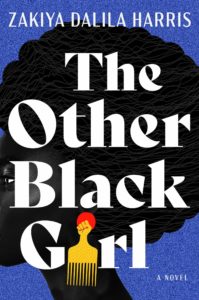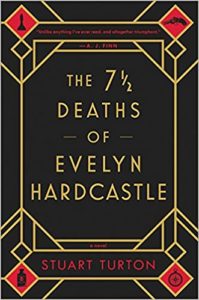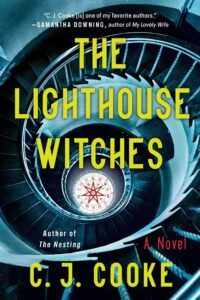You know what’s truly scary? Deciding to introduce a supernatural element to your thriller or mystery novel. You see, a thriller and/or mystery story depends on the writer achieving rock-solid suspension of disbelief, but the second you begin hinting at ghostly goings on, or perhaps the existence of fairies, you essentially tear down the world you’ve constructed for your trusting readers and ask them to step into a new, less certain one. But sometimes, it works. And sometimes a writer manages to do something that’s so wildly imaginative and wholly believable that it seeps into your subconscious and hooks into a primal stratum of fear.
My novel The Lighthouse Witches is a Mystery with a Supernatural Element. It took nerves of steel and over a year of edits to combine the supernatural story with the ‘real world’ story in a way that felt real and authentic. The last thing I wanted was for the supernatural to jolt a reader out of the story, and I also worried that the supernatural and ‘real world’ stories might not speak to each other, that they might carve up the book into two different stories entirely. I felt that the best way to avoid this was to enable the reader to choose what they might believe—that the supernatural was real, or that it was symbolic of an existential theme, like death, or the power of memory. This way, I felt, lay suspension of disbelief.
The books below combine the supernatural with the real in believable ways:

Graham Joyce’s The Silent Land
This slim novel is a compelling and moving read, with its emotional registers achieved in how Joyce handles the supernatural element. Jack and Zoe are on a skiing holiday when disaster strikes—they’re caught up in an avalanche. When they return to their hotel, they find it is deserted, as is the nearby village. As they try to work out what has happened, more and more weirdness ensues: candles don’t burn out, food stays fresh. Time itself has somehow stalled. The snowy landscape and empty hotel provide a chilling backdrop for the unfolding mystery, and what follows is a meditation on mortality, written with tenderness. Come for the thrills, stay for the poetry—and bring tissues.

Amanda Jayatissa’s My Sweet Girl
This smart and twisty debut features a dual timeline, a Sri Lankan protagonist, and a ghostly element that taps into the dual terrors of stalking and obsession. It’s a richly crafted novel, with multiple stories about identity and occupying space as a woman of color. The voice is worth the purchase price alone.

Tana French’s The Secret Place
One of my favorite writers, French deploys the supernatural lightly in her fifth installment of Dublin Murder Squad In this clever psychological suspense, two detectives are called to solve a murder in the grounds of an exclusive boarding school, and their prime suspects are a group of smart-mouthed teenage girls. Without giving too much away, the supernatural here is less a narrative thread than it is an intriguing framework through which to unpick the dynamics of friendship, or the ties between a group of bored, dramatic, and privileged teenage girls.

Zakiya Dalila Harris’ The Other Black Girl
If you’re after a sly, smart, twisty-as-hell character-driven book that examines internalised bias through the lens of the supernatural, this is it. The term ‘genre-defying’ comes up a lot in reviews for the book, and that’s because the book sidesteps expectations and undercuts its own tropes at every turn. Nella is the only black employee at a publishing house, and is thrilled when Hazel, also black, is hired. Rather than becoming an ally, however, Hazel becomes a nemesis, and within this satirical narrative bubbles up another dimension that twists the reader’s expectation whilst simultaneously revealing another tale at its rotten, fanged core.

L. Huchu’s The Library of the Dead
This book fuses mystery, thriller, urban fantasy and dystopia to tell the story of Ropa, a teenage ‘ghost talker’ who converses with the dead of Edinburgh, Scotland. When the ghosts tell Ropa that local kids are being bewitched, she is duty-bound to investigate. Zimbabwean magic is used here against the (dystopic) backdrop of Edinburgh (which has its own stridently ghostly cultural histories) to powerful effect.

Sarah Waters’ The Little Stranger
Few books have seized me the way The Little Stranger did, and I can still recall reading it through my fingers twelve years ago. Waters uses gothic tropes—the crumbling mansion, the troubled protagonist who suspects his new habitat is haunted, fears of madness—to explore questions about class and social mobility. It is precisely the blurring of psychological thriller and ghostly gothic that makes this such a compelling read—Waters is too skilled a writer to offer up easy answers, resolutely leaving it to the reader to decide what kind of tale this is.

Stuart Turton’s The 7 1/2 Deaths of Evelyn Hardcastle
This high concept time-slip story grabbed me from the tagline: ‘Gosford Park meets Groundhog Day by way of Agatha Christie.’ Our protagonist slips in and out of bodies, and the mystery of the murdered woman—Anna—must be solved by piecing together days which restart over and over. This is essentially a locked-room thriller with a side order of WTF.

Sarah Pinborough’s Behind Her Eyes
Did somebody say WTF? Because Pinborough is Queen of WTF. Behind Her Eyes *seems* like a straightforward psychological thriller, with enough wild-eyed characters and unhealthy relationships to make for a rollercoaster read. But then the supernatural element tiptoes in and chucks the whole plot through a Black Hole. Funny thing is, I didn’t think I would buy into the kind of supernatural Pinborough offers here—but she achieves it, and the result is WTF on steroids.
***





















